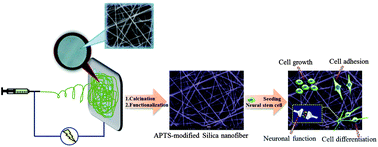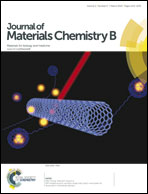Chemically modified electrospun silica nanofibers for promoting growth and differentiation of neural stem cells†
Abstract
In this study, pure silica nanofibers (SNFs) were fabricated by the electrospinning technique. Subsequently, the as-prepared SNFs were modified with (3-aminopropyl) trimethoxysilane (APTS) for applications in neural tissue engineering. The structure and properties of the as-prepared SNFs and the modified SNFs (SNF–APxM, x = 1–3) were evaluated with FTIR, TGA, nitrogen adsorption/desorption isotherms, and SEM. It was found that the surface hydrophilicity of SNF–APxM was lowered upon increasing the amino alkyl group content. The SEM and confocal images revealed that neural stem cells (NSCs) cultured on the electrospun SNFs and SNF–APxM substrates were elongated along the fibers in comparison to poly-D-lysine-coated (PDL-coated) substrate. In addition, a higher degree of proliferation and more responsive cells were observed for the NSCs cultured on the SNF–AP3M substrate than those on the SNFs and the PDL-coated substrates. The results indicated that the APTS-modified silica nanofibers can be potential substrates for regulating growth and differentiation of NSCs in culture.


 Please wait while we load your content...
Please wait while we load your content...